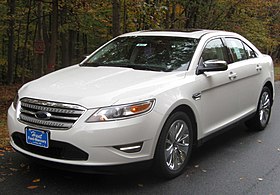
Back فورد توريس Arabic Ford Taurus AST Ford Taurus Catalan Ford Taurus German Ford Taurus Greek Ford Taurus Spanish Ford Taurus Finnish Ford Taurus French פורד טאורוס HE Ford Taurus ID
| Ford Taurus | |
|---|---|
 2010 Ford Taurus Limited | |
| Overview | |
| Manufacturer | Ford |
| Production | October 1985 – October 2006 May 2007 – March 2019 |
| Model years | 1986–2019 (2007 sold only to fleets) |
| Body and chassis | |
| Class | Mid-size car (1985–2007) Full-size car (2007–2019) |
| Layout | Transverse front-engine, front-wheel drive Transverse front-engine, all-wheel drive (2008–2019) |
| Chronology | |
| Predecessor | Ford LTD (for mid-size) |
| Successor | Ford Freestyle/Taurus X (station wagon) Ford Fusion and Ford Five Hundred (sedan; for the fourth generation) Ford Taurus (China) |
The Ford Taurus is an automobile manufactured and marketed by the Ford Motor Company in the United States for model years (MY) 1986-2019. Introduced in late 1985 for the MY 1986, six generations were produced over 34 years, with a hiatus for MY 2006-2007. For MY 1986-2009, Ford marketed the Taurus alongside its rebadged variant, the Mercury Sable; four generations of the high-performance Ford Taurus SHO were manufactured (1989–1999; 2010–2019). The Taurus also served as the basis for the first ever front-wheel-drive Lincoln Continental (1988–2002).
The original Taurus was a milestone for Ford and the American automotive industry, as the first automobile at Ford designed and manufactured using the statistical process control ideas brought to Ford by W. Edwards Deming, a prominent statistician consulted by Ford to bring a "culture of quality" to the enterprise. The Taurus had an influential design that introduced new features and innovations.[1]
In the late 1990s and early 2000s, sales of the Taurus declined as it lost market share to Japanese mid-size sedans and as Ford shifted resources towards developing SUVs. The Taurus was withdrawn after the 2007 model year, with production ending on October 27, 2006.[2] As part of a model line revision, the Taurus and the larger Ford Crown Victoria were to be replaced with the full-size Five Hundred and mid-size Fusion sedans; the Taurus station wagon was replaced with the Ford Freestyle wagon, branded as a crossover SUV. During the 2007 Chicago Auto Show, the nameplates of the Taurus and Sable were revived, intended as 2008 mid-cycle revisions of the Five Hundred. The Freestyle was renamed the Ford Taurus X.[3][4] For the 2010 model year, Ford introduced the sixth-generation Taurus, marking a more substantial model update, alongside the revival of the Taurus SHO; in 2013, the Ford Police Interceptor Sedan was introduced as a successor for its long-running Crown Victoria counterpart.
From 1985 to 2007, the Taurus was a mid-size car, offering front-wheel drive. Initially built on the DN5 platform (renamed the DN101 platform in 1995 and the D186 platform in 1999), the Taurus became a full-size car in 2007, adopting the Volvo-derived D3 platform, offering front- or all-wheel drive. The Taurus was produced as a four-door sedan through its entire production, with a five-door station wagon offered from 1986 to 2005.
All generations of the Taurus were assembled by Chicago Assembly on Chicago's South Side.[5] Prior to its 2006 closure, Atlanta Assembly also produced both the Taurus and Sable.[6] From its 1985 launch to its initial withdrawal following the 2007 model year, Ford assembled 7,519,919 examples of the Taurus.[7] The fifth best-selling Ford nameplate in North America, the Taurus has been surpassed only by the F-Series, Escort, Model T, and Mustang.[8][9][10] Between 1992 and 1996, the Taurus was the best-selling car nameplate in the United States, overtaken by the current title holder in 1997, the Toyota Camry.[11][12]
- ^ Cite error: The named reference
Taubwas invoked but never defined (see the help page). - ^ "Last Taurus Rolls Off Ford Assembly Line". Fox News. October 27, 2006. Archived from the original on October 31, 2006. Retrieved October 27, 2006.
- ^ "2008 Ford Taurus features more power, style, and more standard safety features" (Press release). Media. Ford.com. February 7, 2007. Archived from the original on March 6, 2007. Retrieved February 7, 2007.
- ^ "Ford strengthens crossover leadership with introduction of new 2008 Taurus X" (Press release). Media. Ford.com. February 7, 2007. Archived from the original on May 4, 2011. Retrieved February 7, 2007.
- ^ corporate.ford.com
- ^ "The Ford Taurus Celebrates 30 Years; Born & Raised in Chicago" - Charles W. Johnson, Chicago Now, October 29, 2015
- ^ "Production Figures". Taurus/Sable Encyclopedia. Taurus Car Club of America. Retrieved September 25, 2009.
- ^ O'Neill, Mike (May 5, 2004). "Ford Nameplates join Five Million Club" (Press release). Media.Ford.com. Archived from the original on October 15, 2007. Retrieved April 4, 2008.
- ^ O'Neil, Mike. "Ford's F-series sets industry sales truck records". Ford Trucks.com. Archived from the original on October 15, 2007. Retrieved April 4, 2008.
- ^ "Farewell, Ford Escort" (Press release). Media.Ford.com. July 21, 2000. Archived from the original on May 4, 2011. Retrieved April 4, 2008.
- ^ DiPetro, John (April 18, 2003). "Inside Line: Ford Taurus/Mercury Sable". Edmunds. Archived from the original on June 15, 2006. Retrieved May 29, 2006.
- ^ Mayne, Eric (April 19, 2005). "End of Ford Taurus closes era". Detroit News. Archived from the original on July 30, 2012. Retrieved May 16, 2006.